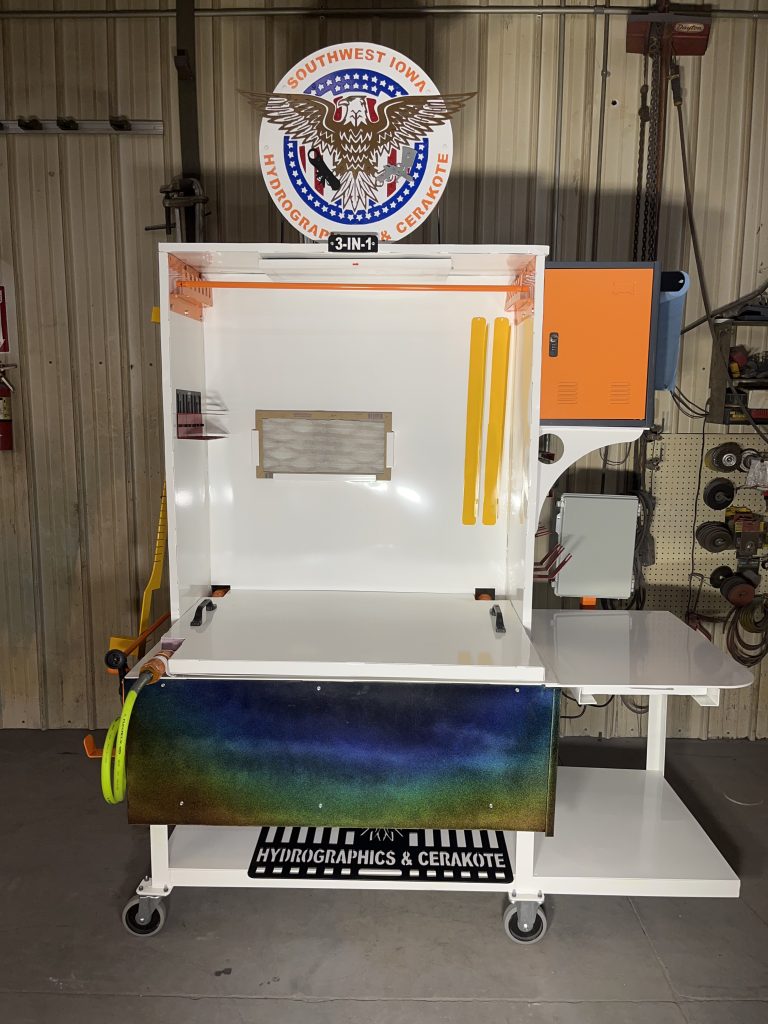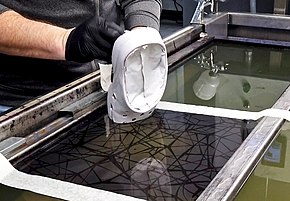CALL: 402-630-1544
UNDERWOOD, IA - CALL 402-630-1544


History
Water transfer printing, also known as immersion printing, water transfer imaging, hydro dipping, water marbling, cubic printing, Hydrographics, or HydroGraphics, is a method of applying printed designs to three-dimensional surfaces. The resulting combinations may be considered decorative art or applied art. The hydrographic process can be used on metal, plastic, glass, hardwoods, and various other materials. Created in Japan in the 1980s, the water transfer printing process is extensively used to decorate items that range from entire all-terrain vehicles and car dashboards to small items like bike helmets or other automotive trim. Films can be applied to all types of substrates including plastic, fiberglass, wood, ceramics, and metal.

Process of Water Transfer Printing (Hydrographics)
In the process, the substrate piece to be printed first goes through the entire painting process: surface preparation, priming, painting, and clear coating. Depending on some types of plastics, some substrates may also need to be flame treated before a base coat is applied. A PVA hydrographic film, which has been printed on with a desired graphic image using latex or pigment-based inks, is carefully placed on the water’s surface in the dipping tank. Recommended water temperature for the dip tank is 90° F (32° C). The clear hydrographic film is water-soluble and should dwell on top of the water for 60-75 seconds.
Any remaining residue is then rinsed off thoroughly. The ink adheres to the desired surface and it cannot be washed off easily. It is then allowed to dry. The adhesion is a result of the chemical components of the activator softening the base coat layer and allowing the ink to form a bond with it. One of the most common causes of a failure to achieve adhesion between the two layers is a poorly applied activator. This can be either too much activator being applied or too little.


What can be Hydro-dipped?
Basically, you can use any material that can withstand being submerged in water for hydrographic designs. These materials may be metal, plastic, wood, glass, ceramics, fiberglass and various other materials.
Some items include:
- Car Parts
- Engine components
- Dashboards
- Household Items
- Electronics, such as; mouse, keyboards, etc
- Firearms
- Tumblers and mugs
- Musical Instruments
- Deer skulls
- Rims
- Motorcycle fuel tanks
Cerakote
Cerakote is a ceramic based finish that can be applied to a variety of materials including metals, plastics, polymers, and wood. It has been specially engineered to provide many of the same benefits that powder coating does and then some. It is known for its extreme durability and high performance, holding up incredibly well against impact, abrasion, corrosion, and chemical penetration. Cerakote also exhibits extremely high levels of heat stability, with some types withstanding temperatures upwards of 900 degrees Fahrenheit without failing. It has a very smooth and clean appearance, comes in a wide range of colors, and will maintain its true color for years to come. It also happens to be very easy to clean.
Exhaust and Engine Parts
Cerakote has several properties that make it perfectly suitable for exhaust and engine parts in your car. First, it is extremely heat resistant and has been rated safe up to a 900 degrees Fahrenheit base metal temperature and 2000 degrees Fahrenheit exhaust gas temperature. Second, it is highly resistant to friction, which means that it increases the functionality of lubricants in your engine. Third, it can reduce under-hood temperatures by over 30 degrees. Overall, Cerakote coating for your engine parts will increase the performance of your engine system and lengthen the lifespan of your engine parts.
Firearms
Many opt for a Cerakote finish when refinishing their firearms for its high quality and affordability. A Cerakote finish on a firearm will resist corrosion, rust, and scratches, and you can choose from a variety of colors for your finish. Many who opt for a Cerakote finish on their guns appreciate how it makes for low maintenance, as it eliminates the need to oil the exterior of your gun for corrosion protection
Sporting Equipment
Knives and scopes are commonly finished with Cerakote as well. The special finish adds durability and helps these pieces of equipment stand up to the harsh elements they are so frequently exposed to.